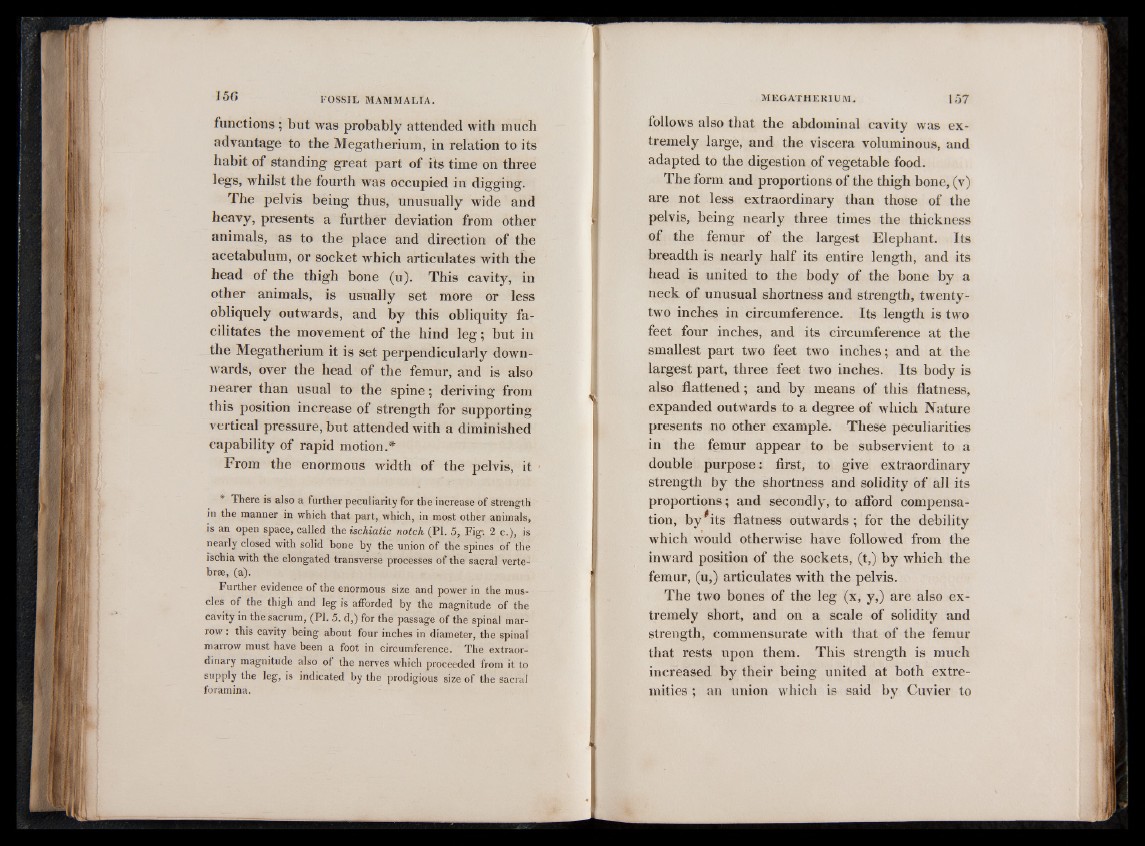
functions; but was probably attended with much
advantage to the Megatherium, in relation to its
habit of standing great part of its time on three
legs, whilst the fourth was occupied in digging.
The pelvis being thus, unusually wide and
heavy, presents a further deviation from other
animals, as to the place and direction of the
acetabulum, or socket which articulates with the
head of the thigh bone (u). This cavity, in
other animals, is usually set more or less
obliquely outwards, and by this obliquity facilitates
the movement of the hind leg; but in
the Megatherium it is set perpendicularly downwards,
over the head of the femur, and is also
nearer than usual to the spine; deriving from
this position increase of strength for supporting
vertical pressure, but attended with a diminished
capability of rapid motion.*
From the enormous width of the pelvis, it
* There is also a further peculiarity for the increase of strength
in the manner in which that part, which, in most other animals,
is an open space, called the ischiatic notch (PI. 5, Fig”. 2 c.), is
nearly closed with solid bone by the union of the spines of the
ischia with the elongated transverse processes of the sacral vertebrae,
(a).
Further evidence of the enormous size and power in the muscles
of the thigh and leg is afforded by the magnitude of the
cavity in the sacrum, (PI. 5. d,) for the passage of the spinal marrow
: this cavity being about four inches in diameter, the spinal
marrow must have been a foot in circumference. The extraordinary
magnitude also of the nerves which proceeded from it to
supply the leg, is indicated by the prodigious size of the sacral
foramina.
follows also that the abdominal cavity was extremely
large, and the viscera voluminous, and
adapted to the digestion of vegetable food.
The form and proportions of the thigh bone, (v)
are not less extraordinary than those of the
pelvis, being nearly three times the thickness
of the femur of the largest Elephant. Its
breadth is nearly half its entire length, and its
head is united to the body of the bone by a
neck of unusual shortness and strength, twenty-
two inches in circumference. Its length is two
feet four inches, and its circumference at the
smallest part two feet two inches; and at the
largest part, three feet two inches. Its body is
also flattened; and by means of this flatness,
expanded outwards to a degree of which Nature
presents no other example. These peculiarities
in the femur appear to be subservient to a
double purpose: first, to give extraordinary
strength by the shortness and solidity of all its
proportions; and secondly, to afford compensation,
by* its flatness outwards; for the debility
which would otherwise have followed from the
inward position of the sockets, (t,) by which the
femur, (u,) articulates with the pelvis.
The two bones of the leg (x, y,) are also extremely
short, and on a scale of solidity and
strength, commensurate with that of the femur
that rests upon them. This strength is much
increased by their being united at both extremities
; an union which is said by Cuvier to